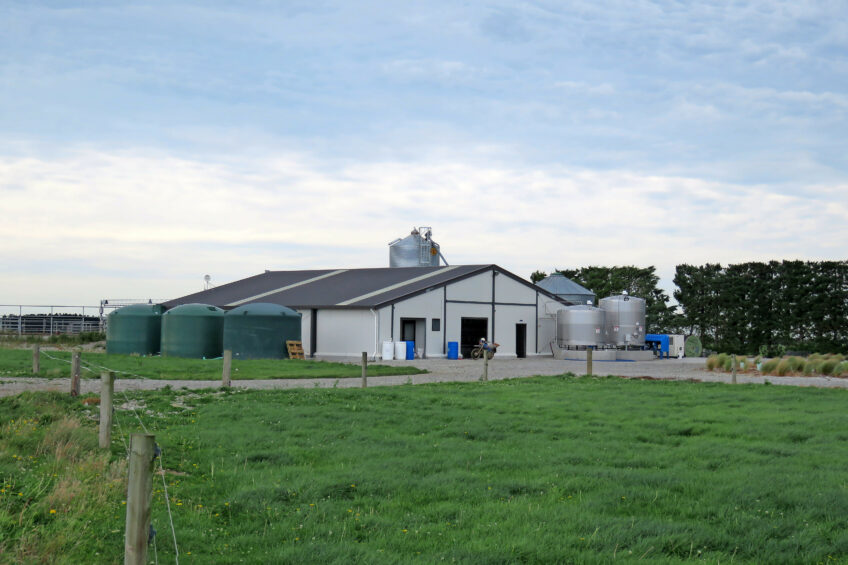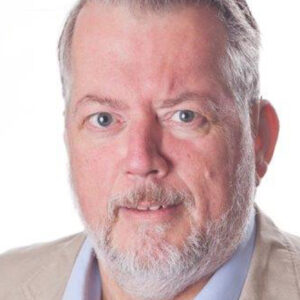NZ farm maximising milk production

In New Zealand’s South Island, Mark and Pennie Saunders milk just under 2,000 dairy cows. The entrepreneurs consider availability of labour and environmental pressure as their biggest threats while they aim for optimal milk production.
Their cows and young stock graze 24 hours a day, 365 days a year in the pastures. Mark and Pennie Saunders haven’t invested heavily in buildings. At the home location in Ashburton, 90km south of Christchurch there are 3 sheds, one which is out of use, the second is to house newborn calves and the third houses some tractors and machines.
|
The 80-stall rotary milking parlour from 2004 is almost fully written off. In the first years 1,200 cows went through it twice a day and after an expansion in 2007 that number increased to 1,650 cows per day, 10 months per year. Since 2015 ‘only’ 1,350 cows per day are milked in the old rotary. The entrepreneurs bought 130 hectares from the neighbour in 2015 and started a new site with 650 dairy cows on a 54-stall rotary milking parlour. “The decision to start at the second location is dictated by the scarcity of capable employees,” says Mark. “It is for sure financially more attractive to milk extra hours in the 80 stands, but with 1,650 cows the employees were already milking for 9 hours a day. It’s hard to keep employees this way. They only thrive if their work is alternated with another task.”

Labour scarce
Mark and Pennie view labour demand as the biggest issue for the future. This is due of 2 reasons:
- The increase in scale in dairy farming in New Zealand. The number of dairy cows has grown from 3.7 to just under 5 million since 2001, while the number of farms has shrunk from 13,649 to 11,918. The average farm grew from 229 to 419 cows.
- Growth has taken place mainly on the South Island. In 2001, the South housed 14% of the dairy cows, now it’s almost 45%. “Of our New Zealand employees, only one comes from a dairy farm. That means that we have to train the staff ourselves.”
The New Zealanders have 12 people year-round on the payroll and all employees get free housing.
In addition to the 12 permanent people on the payroll, there are 1 or 2 backpackers at the start of the milking year, in the calving period in August. These extra hands are desperately needed then, because on average 50 cows per day calve during that period. “Our top day in 2016 was with 82 births,” Pennie explains.
It would make sense to have employees who specialise in tasks but that does not happen. “The people who are good with young calves work more with the calves during that period, but they also do other chores,” says Pennie. “We do not want people who would only drive a tractor or would only milk cows. That would make our operation too vulnerable. Therefore, everyone has the opportunity to do everything.”
Block calving is risky
Like most New Zealand dairy farmers, the Saunders work with block calving. The cows calve between 25 July and 25 September, with 70% in the first 6 weeks. The insemination season that lasts 6 weeks starts on 24 October. After that, Hereford and beef cross bulls go into the herd for 3 weeks to fertilise the last cows. None of these calves are kept for replacement because good, problem-free fertility and calving within the year are a must in the block calving system.
This insemination period is a hectic and important period, with a self-employed person taking care of insemination. The milking starts at 5am, at 6am the inseminator starts. They can work easily, because in addition to the waiting pen for 600 cows there is a selection pen that can easily accommodate 60 cows. Boxes for 13 cows are situated next to the selection area. “The inseminator works till 7.30am and returns at 9am to inseminate the last cows,” says Mark.
The entrepreneurs do not use sexed semen, however, Pennie sees a plus in using it but Mark is still too sceptical to use it. “The conception results are lower, I do not want to run any risk.” A decrease of the conception rate by 1 point means roughly 20 cows fewer, or much later in production. If you have to fill that gap by raising extra calves, it costs about € 25,000 per percent. If it falls 5%, that would be a significant drop in income. “Regional manager of Dutch breeding company CRV, Mark Duffy, confirms the lower conception rate when using sexed semen. “You can put that to good use on smaller farms because more attention can then be paid to the insemination moment. The risk is still too great at these large-scale companies.”

Irrigation with sensors
The Saunders have one of the largest dairies in the Ashburton area. However, the milk production per hectare is only just above 15,450kg, in a region with a sub-mediterranean climate and enough water for irrigation. In addition, the ration consists of pasture grass plus some grass silage at the end of the milking season when the drought depresses the grass production. On top of that Saunders feeds the cows 500kg of purchased silage or grain and he grows 19ha of fodder beets which the cows themselves ‘harvest’ during the dry period.
Despite the relatively low nitrogen-pressure, the nitrogen load is an issue in this region. The large dairy factories Fonterra and Synlait, comply with National Standards and help promote and enforce their suppliers to work according to Good Management Practices to reduce nitrogen leaching. For this purpose, specific plans have been drawn up for each region. For Saunders the most important factors are irrigation and the moment of fertilisation. In the region there is around 700mm of rain per year. On top of that Saunders irrigates 350 to 400mm through pivots. Manure from the lagoons at the rotaries is irrigated. “At the home location, we can store manure for 25 days, at the second site 55 days. The longer storage was an investment that is very profitable because we can now fertilise more minerals at the right time.”
Saunders not only invested in manure storage. He also placed sensors that determine the moisture content of the soil. “Combined with weather information, I can now determine much better whether irrigation is necessary. Every day that the irrigation is not running saves € 724.216 (US$ 876,63) in direct costs and reduces the environmental impact.”
Nitrogen pressure in 2030 has to be 36% less than in 2009, for Saunders this regulation is not a problem. “The fact is that agriculture is becoming less and less popular in New Zealand. We have to work on our license to produce. When we don’t, laws will be declared. We are better off when society accepts that we are arranging things as a sector within a reasonable period of time.”
Heavily financed
The company has grown considerably since 2004. The farm expanded by 360 hectares by purchasing from multiple neighbours, a new milking site has been realised with a 54-stage rotary milking parlour and the number of cows has grown from 1,200 to 1,950, with accompanying young stock. At a land price of around € 34,762 (US$ 42,098) per hectare, that was a big investment. The equity capital is now around 45%, with a free market value of the company of € 27.2 million (US$ 32.9) – € 20.2 million (US$ 24.5) of which is for land, machines and buildings, € 3.4 million (US$ 4,209,454) for livestock and stocks and € 3.4 million for compulsory share capital in Fonterra. The interest and repayment charges fluctuate around the € 0.81 (US$ 0.98) per kg milk solids. The average production in 2016-2017 was 450kg milk solids, this season the entrepreneurs expect to end up 465kg. “I do not know how many kilogrammes of milk the cows produce. We are not rewarded in kilogrammes,” Mark says. That is, at 8.77% milk solids, about 5,300 litres of milk per cow.
The farmers can meet the sturdy bank load because of their low cost price. That is € 2 (US$ 2.45) per kg milk solids, € 0.52 (US$ 0.63) of which is for feeding a grazing, € 0.46 (US$ 0.56) for labour, € 0.28 (US$ 0.35) for fertiliser, € 0.20 (US$ 0.24) for irrigation and water, € 0.20 (US$ 0.24) expenses on animal health and € 0.28 (US$ 0.35) for remaining costs. “As soon as we take € 2.8 (US$ 3.50) per kg milk solids, we are really in the plus. This year we receive around € 3.4 (US$ 4.2), so it’s a good year. But the last 2 years were hard, a lot of money is used to maintain a farm this size. We have noticed that the banks are not as easy as in the past. They now want farmers to pay back more urgently, to cover the losses in recent years. This is new. Within 5 years, we want to buy out my father-in-law, who owns 20% of the company. That has been done at market value, I would not want it any other way, as this way keeps one focused. Whomever gets a company ‘donated’ becomes a lazy entrepreneur.”
Join 13,000+ subscribers
Subscribe to our newsletter to stay updated about all the need-to-know content in the dairy sector, two times a week.


 Profile
Profile








